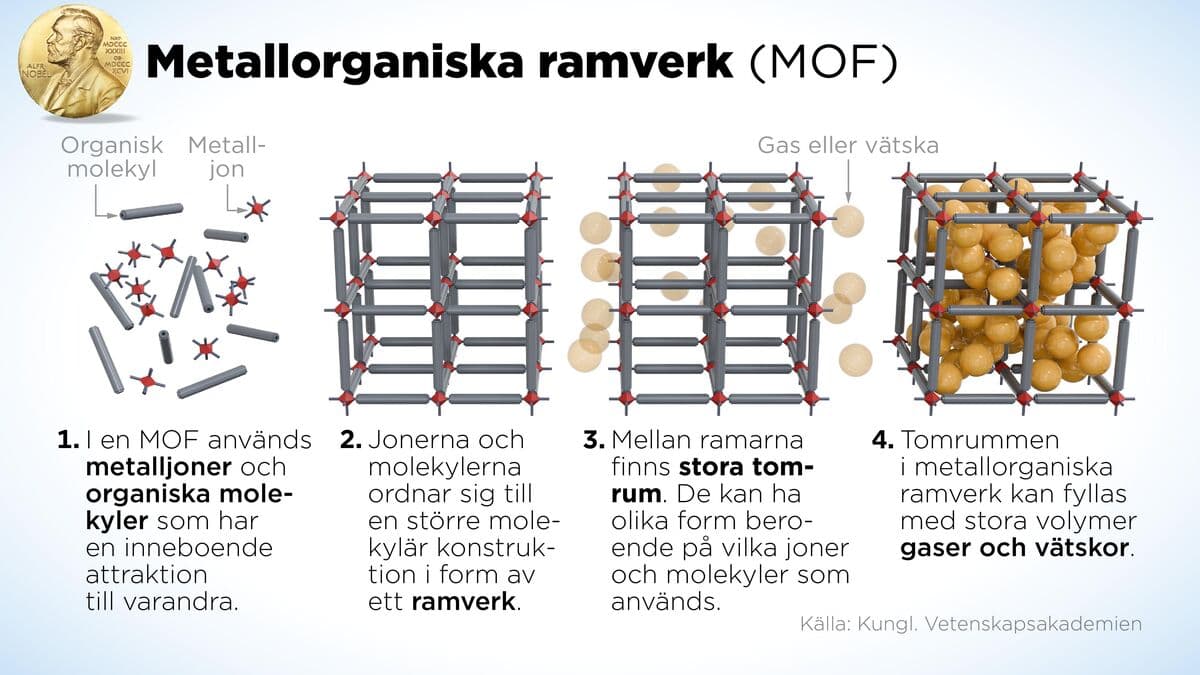The three chemists are awarded the prize for having "created new spaces for chemistry", announces the Nobel Committee.
This year's prize is about frameworks, says Olof Ramström, expert within the Nobel Committee, at the announcement.
The frameworks consist of metal ions with organic molecules, which are linked together into a kind of scaffolding – metal-organic frameworks, MOFs.
These MOFs form porous materials that can capture or separate different substances. MOFs have been likened to sponges, or the "Harry Potter" character Hermione's magical handbag – small on the outside, infinitely spacious on the inside.
A few grams of such a material, roughly the size of a sugar cube, can contain as large a surface area as a football field. Then you understand that the materials are good at capturing or storing gases, for example, says Peter Brzezinski, professor of biochemistry and secretary of the chemistry prize committee.
Water from air
The prize winners' discoveries have led to the construction of tens of thousands of different MOFs. Some of them can contribute to solving some of humanity's greatest challenges.
They could, for example, extract water from desert air.
In one day, you can get several liters of water from a kilo of the material, says Peter Brzezinski.
Water-capturing materials are already on the market, while other MOF materials are under development, according to Brzezinski.
Some say this will be the material of the century. I think only the imagination sets the limit, he says.
Other areas of use for MOFs can be storage of hydrogen, separation of PFAS chemicals from water, or delivery of medicines in the body.
Three friends
Prize winner Susumu Kitagawa, who was present at the press conference by phone, says he is deeply honored to be awarded the Nobel Prize.
My dream is to capture air and separate air from, for example, carbon dioxide or oxygen, and convert it into usable material, he says.
The Nobel Committee has managed to reach all three to tell them that they have been awarded the prize.
All three said they were very happy to share the prize with the other two, because all three are friends, says Olof Ramström.
Sophie Tanha/TT
Anna Lena Wallström/TT
Facts: The Nobel Prize in Chemistry
TT
Briton Richard Robson, Melbourne University in Australia, tested in 1989 to utilize the atoms' inherent properties in a new way. He made a construction with copper ions and organic molecules. The substances were drawn to each other and formed "like a diamond, filled with plenty of cavities".
Susumu Kitagawa at Kyoto University and Jordanian-American Omar Yaghi at Berkeley in the USA took Robson's discovery further.
Kitagawa showed that gases can flow in and out of the metal-organic frameworks, and predicted that they would be able to become flexible.
Yaghi created a very stable MOF material and showed that it is possible to modify MOFs in a rational way so that they get new and desired properties.
Source: Royal Swedish Academy of Sciences





